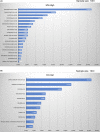Real-world data on microsatellite instability status in various unresectable or metastatic solid tumors
- PMID: 33403729
- PMCID: PMC7935787
- DOI: 10.1111/cas.14798
Real-world data on microsatellite instability status in various unresectable or metastatic solid tumors
Abstract
Microsatellite instability-high (MSI-H) is an important biomarker for predicting the effect of immune checkpoint inhibitors (ICIs) on advanced solid tumors. Microsatellite instability-high is detected in various cancers, but its frequency varies by cancer type and stage. Therefore, precise frequency is required to plan ICI therapy. In this study, the results of MSI tests actually carried out in clinical practice were investigated. In total, 26 469 samples of various cancers were examined between December 2018 and November 2019 to determine whether programmed cell death-1 blockade was indicated. The results of MSI tests were obtained for 26 237 (99.1%) of these samples. The male : female ratio was 51:49 and mean age was 64.3 years. In all samples, the overall frequency of MSI-H was 3.72%. By gender, the frequency of MSI-H was higher in female patients (4.75%) than in male patients (2.62%; P < .001). A comparison by age revealed that the frequency of MSI-H was significantly higher in patients younger than 40 years of age (6.12%) and 80 years or older (5.77%) than in patients aged between 60 and 79 years (3.09%; P < .001). Microsatellite instability-high was detected in 30 cancer types. Common cancer types were: endometrial cancer, 16.85%; small intestinal cancer, 8.63%; gastric cancer, 6.74%; duodenal cancer, 5.60%; and colorectal cancer, 3.78%. Microsatellite instability-high was detected in cancer derived from a wide variety of organs. The frequency of MSI-H varied by cancer type and onset age. These data should prove especially useful when considering ICI treatment.
Keywords: PD-1 blockade; advanced solid tumor; immune checkpoint inhibitor; microsatellite instability; mismatch repair.
© 2021 The Authors. Cancer Science published by John Wiley & Sons Australia, Ltd on behalf of Japanese Cancer Association.
Conflict of interest statement
K. Akagi reports research funding received from Ono and Falco Biosystems and lecture fees received from MSD. E. Oki reports lecture fees received from Bayer, Chugai, Eli Lilly, Merck, Ono, Taiho, Takeda, and Yakult Honsha. H. Taniguchi reports honoraria received from Bayer, Bristol‐Myers Squibb, Chugai, Daiichi Sankyo, Eli Lilly, MBL, Merck Serono, Mitsubishi Tanabe Pharma, MSD, Nippon Kayaku, Novartis, Sanofi, Taiho, Takeda, and Yakult Honsha and research funding received from Array Bio Pharma, Daiichi Sankyo, Dainippon Sumitomo Pharma, MSD, Novartis, Ono, Sysmex, and Takeda. D. Aoki reports research funding received from Chugai and Takada and honoraria received from Astra Zeneka, Chugai, and MSD. T. Kuwata reports research funding from Ono and Daiichi Sankyo and honoraria from MSD, Astra Zeneca, and Taiho. T. Yoshino reports research funding received from Chugai, Daiichi Sankyo, Dainippon Sumitomo Pharma, GSK, MSD, Novartis, Ono, Parexel, and Sanofi. The other authors have no conflicts of interest.
Figures




Similar articles
-
The real-world data on microsatellite instability status in various unresectable or metastatic solid tumors.Cancer Sci. 2021 Jan 11. doi: 10.1111/cas.14804. Online ahead of print. Cancer Sci. 2021. PMID: 33426756
-
Efficacy of Pembrolizumab in Patients With Noncolorectal High Microsatellite Instability/Mismatch Repair-Deficient Cancer: Results From the Phase II KEYNOTE-158 Study.J Clin Oncol. 2020 Jan 1;38(1):1-10. doi: 10.1200/JCO.19.02105. Epub 2019 Nov 4. J Clin Oncol. 2020. PMID: 31682550 Free PMC article. Clinical Trial.
-
Subcutaneous envafolimab monotherapy in patients with advanced defective mismatch repair/microsatellite instability high solid tumors.J Hematol Oncol. 2021 Jun 21;14(1):95. doi: 10.1186/s13045-021-01095-1. J Hematol Oncol. 2021. PMID: 34154614 Free PMC article. Clinical Trial.
-
Clinical Development of Immunotherapy for Deficient Mismatch Repair Colorectal Cancer.Clin Colorectal Cancer. 2020 Jun;19(2):73-81. doi: 10.1016/j.clcc.2020.02.002. Epub 2020 Feb 10. Clin Colorectal Cancer. 2020. PMID: 32173280 Review.
-
Microsatellite instability and immune checkpoint inhibitors: toward precision medicine against gastrointestinal and hepatobiliary cancers.J Gastroenterol. 2020 Jan;55(1):15-26. doi: 10.1007/s00535-019-01620-7. Epub 2019 Sep 7. J Gastroenterol. 2020. PMID: 31494725 Free PMC article. Review.
Cited by
-
Lynch syndrome screening in patients with young-onset extra-colorectal Lynch syndrome-associated cancers.Int J Clin Oncol. 2024 Nov;29(11):1696-1703. doi: 10.1007/s10147-024-02609-w. Epub 2024 Aug 26. Int J Clin Oncol. 2024. PMID: 39187737
-
Genomic Landscape of Endometrial, Ovarian, and Cervical Cancers in Japan from the Database in the Center for Cancer Genomics and Advanced Therapeutics.Cancers (Basel). 2023 Dec 27;16(1):136. doi: 10.3390/cancers16010136. Cancers (Basel). 2023. PMID: 38201563 Free PMC article.
-
Two Cases of Thymic Cancer in Patients with Lynch Syndrome.Intern Med. 2023 Feb 15;62(4):649-653. doi: 10.2169/internalmedicine.9729-22. Epub 2022 Jul 29. Intern Med. 2023. PMID: 35908972 Free PMC article.
-
Potential pathogenic germline variant reporting from tumor comprehensive genomic profiling complements classic approaches to germline testing.NPJ Precis Oncol. 2023 Aug 11;7(1):76. doi: 10.1038/s41698-023-00429-1. NPJ Precis Oncol. 2023. PMID: 37568048 Free PMC article.
-
A pathological complete response after immunotherapy with pembrolizumab for distal duodenal adenocarcinoma caused by Lynch syndrome: a case report.Int Cancer Conf J. 2023 Jul 26;12(4):279-284. doi: 10.1007/s13691-023-00622-w. eCollection 2023 Oct. Int Cancer Conf J. 2023. PMID: 37577343 Free PMC article.
References
-
- Patel SP, Kurzrock R. PD‐L1 expression as a predictive biomarker in cancer immunotherapy. Mol Cancer Ther. 2015;14:847‐856. - PubMed
-
- Dudley JC, Lin MT, Le DT, Eshleman JR. Microsatellite instability as a biomarker for PD‐1 blockade. Clin Cancer Res. 2016;22:813‐820. - PubMed
-
- Mishima S, Taniguchi H, Akagi K, et al. Japan Society of Clinical Oncology provisional clinical opinion for the diagnosis and use of immunotherapy in patients with deficient DNA mismatch repair tumors, cooperated by Japanese Society of Medical Oncology, First Edition. Int J Clin Oncol. 2020;25:217‐239. - PMC - PubMed
MeSH terms
Substances
Grants and funding
LinkOut - more resources
Full Text Sources
Other Literature Sources
Medical

